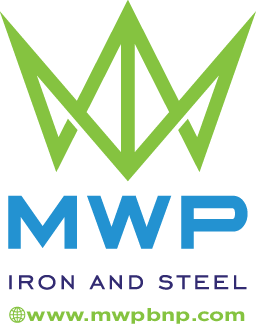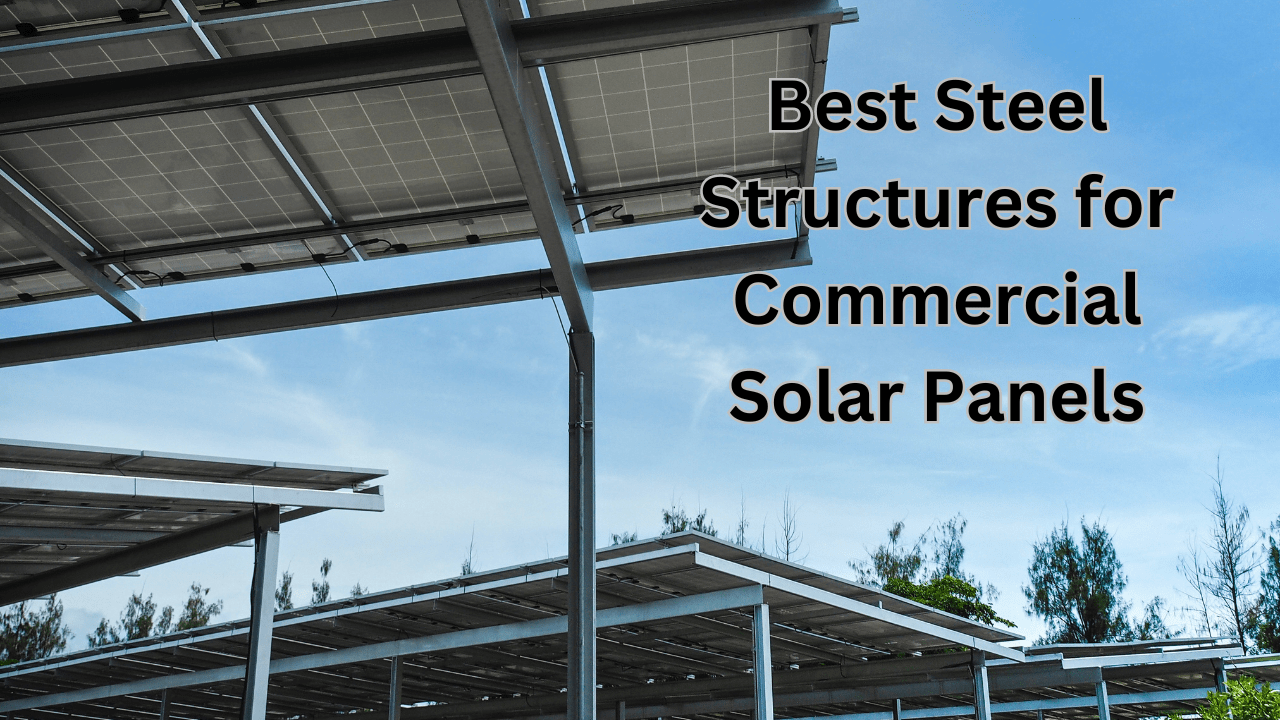A Guide to Strength, Efficiency, and Sustainability
Best Steel Structures: In today’s world, businesses are increasingly seeking sustainable solutions to reduce their environmental impact and energy costs. Commercial solar panels offer a compelling option, harnessing the power of the sun to generate clean electricity. But these panels require a strong and reliable foundation – the steel structure.
This comprehensive guide explores the best steel structures for commercial solar panels, considering factors like durability, cost-effectiveness, and ease of installation. We’ll delve into the different types of structures, their advantages and disadvantages, and key considerations for choosing the right one for your project.
Why Steel for Commercial Solar Panel Structures?
Steel reigns supreme as the preferred material for commercial solar panel structures due to its numerous advantages:
- Strength and Durability: Steel boasts exceptional strength-to-weight ratio, ensuring the structure can withstand harsh weather conditions like wind, snow, and hail. This translates to a long lifespan, typically exceeding 25 years, matching the lifespan of the solar panels themselves.
- Versatility: Steel is incredibly adaptable and can be customized to accommodate various roof shapes, sizes, and panel layouts. Whether you’re installing ground-mounted systems, rooftop solar arrays, or carports with integrated panels, steel offers the flexibility to fit your project’s specific needs.
- Cost-Effectiveness: While the upfront cost of steel structures might be slightly higher than some alternatives like wood, steel’s durability minimizes long-term maintenance and replacement expenses. Additionally, steel structures often qualify for government incentives and tax credits for adopting renewable energy solutions.
- Sustainability: Steel is a highly recyclable material. At the end of its lifespan, the steel structure can be dismantled and recycled, minimizing environmental impact.
- Fire Resistance: Steel has superior fire resistance compared to wood or other combustible materials, enhancing overall safety for your commercial property.
Types of Steel Structures for Commercial Solar Panels
Commercial solar panel structures come in various configurations, each with its own set of benefits and drawbacks. Here’s a breakdown of the most common types:
1. Ground-Mounted Systems:
- Description: Freestanding structures ideal for open spaces with ample ground availability. They consist of galvanized steel posts driven into the ground, supporting horizontal beams that hold the solar panels at an optimal angle for sun exposure.
- Advantages:
- Easy to install and maintain.
- Highly scalable for large-scale solar projects.
- Offers maximum flexibility in panel tilt and orientation.
- Disadvantages:
- Requires significant ground space, which might not be feasible for all businesses.
- May have a higher initial cost due to the materials required for extensive ground support.
2. Rooftop Systems:
- Description: Mounted directly onto the existing commercial building roof. They come in various configurations, including ballasted systems (using weights to secure panels) and penetrating systems (anchored directly to the roof structure).
- Advantages:
- Maximizes available space on your property.
- Reduces the visual impact compared to ground-mounted systems.
- Can potentially provide some shade or cooling benefits for the building.
- Disadvantages:
- Requires a structurally sound roof capable of supporting the additional weight of the panels and structure.
- Installation might be more complex depending on the roof type and design.
- May require roof modifications, potentially impacting roof warranties.
3. Solar Carports:
- Description: Multifunctional structures that provide covered parking while simultaneously generating clean energy. They utilize steel posts and beams to support a roof structure where solar panels are mounted.
- Advantages:
- Creates valuable covered parking spaces for employees, customers, or vehicles.
- Offers shade and protection from the elements for parked vehicles.
- Provides additional usable space on your property.
- Disadvantages:
- Requires a significant initial investment compared to ground-mounted systems.
- May not be suitable for all businesses depending on parking space needs.
| Steel Structure Type | Advantages | Disadvantages | Ideal Applications |
|---|---|---|---|
| Ground-Mounted | Easy to install and maintain, highly scalable, flexible panel positioning | Requires large open space, potentially higher initial cost | Large-scale solar farms, businesses with ample land |
| Rooftop | Maximizes available space, reduces visual impact, potential shade benefits | Requires structurally sound roof, complex installation, potential roof modifications | Businesses with suitable commercial rooftops |
| Solar Carports | Provides covered parking, shade for vehicles, additional usable space | Higher initial investment, may not be suitable for all businesses | Businesses with parking space needs seeking dual functionality |
Continued: Best Steel Structures for Commercial Solar Panels
Following up on the previous section, here are some additional considerations for choosing the right steel structure for your commercial solar panels:
- Site Conditions: A professional assessment of your property’s soil composition (for ground-mounted systems) and roof strength (for rooftop systems) is crucial. This helps determine the appropriate foundation design and ensures the structure can withstand wind and snow loads specific to your location.
- Solar Panel Specifications: Different solar panels might have weight and size variations. Consider the compatibility of the steel structure with the chosen panels to ensure proper support and optimal tilt angle for maximum energy generation.
- Maintenance Considerations: Choose a steel structure design that allows for easy access for cleaning and occasional maintenance of the solar panels. This might involve incorporating walkways or utilizing a non-penetrating roof mounting system for rooftops.
- Aesthetics: While functionality is paramount, consider the visual impact of the steel structure on your property. Explore options for different finishes or color coatings that complement your existing building design.
Choosing a Reputable Steel Structure Manufacturer and Installer
Selecting a reliable steel structure manufacturer and installer is vital for a successful solar panel project. Here are some key factors to consider:
- Experience and Expertise: Look for a company with a proven track record in designing and installing commercial solar panel structures. Ask for references and check their portfolio to see examples of similar projects.
- Engineering and Design Services: Ensure the company provides comprehensive engineering services to design a structure that meets your specific needs and complies with local building codes.
- Quality Materials and Fabrication: Verify that the company uses high-quality, hot-dip galvanized steel for superior corrosion resistance. Inquire about their fabrication process and quality control measures.
- Warranty and Guarantees: Opt for a company that offers a comprehensive warranty on the steel structure, covering materials and workmanship.
- Installation Expertise: Choose an installer with experienced and certified crews who adhere to safety protocols and best practices during installation.
The Benefits of Investing in Commercial Solar Panels with Steel Structures
The decision to install commercial solar panels with a steel structure offers significant advantages for your business:
- Reduced Energy Costs: Solar panels generate clean electricity, significantly reducing your reliance on the grid and lowering your monthly electricity bills.
- Increased Property Value: Commercial properties with solar panel installations are often viewed as more sustainable and energy-efficient, potentially increasing their market value.
- Environmental Benefits: By harnessing solar energy, you contribute to reducing greenhouse gas emissions and promoting a cleaner environment.
- Government Incentives and Tax Credits: Many governments offer attractive incentives and tax credits to encourage businesses to adopt renewable energy solutions.
- Long-Term Return on Investment (ROI): While there’s an initial investment in the solar panel system and steel structure, the long lifespan of both ensures a high ROI over time, with significant energy cost savings.
Conclusion
Selecting the right steel structure for your commercial solar panels is a crucial step in maximizing the benefits of your investment. By carefully considering the different types of structures, their suitability for your site and project needs, and by partnering with a reputable manufacturer and installer, you can ensure a reliable and efficient solar energy system for your business.
Moving Forward:
This guide provides a comprehensive overview of steel structures for commercial solar panels. For the next steps, consider:
- Consulting with a Solar Installer: Schedule consultations with qualified solar installers who can assess your property and provide customized recommendations for the best steel structure type and system design.
- Obtaining Quotes: Gather quotes from several reputable steel structure manufacturers and installers to compare pricing, services offered, and warranties.
- Securing Financing: Explore available financing options, including government incentives and loans tailored to renewable energy projects.

